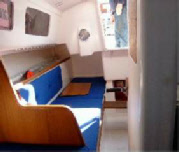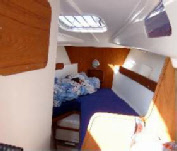# The New Jaguar "215" by Laurie Milton
On Friday, 27th September, (02), I was invited by the new owners of Jaguar Yachts, Ltd., to try the first production yacht of the new company. It will be known as the Jaguar 215, & is a development of the John Mullins design, the 21.
It was a glorious day but with so little wind, that it was never going to be a testing sail, & as there is a comprehensive test information available on the original 21, why duplicate it? So, in what way, if at all, is the 215 different or improved over the 21?
I arrived on the pontoon in Titchmarsh marina, prior to Paul Randall, who is the new owners of Jaguar Yachts Ltd., & this. gave me an opportunity to have a good look at the boat, & an extremely attractive looking craft it is, too. The pulpit follows now the rake of the bow, instead of being brought up short, as it were; the rubbing strake is neater,& the stanchions would do justice to a much larger boat. They are truly substantial. Indeed all the deck fittings are improved in themselves &/or their positioning. A good example of this is the cockpit. The 215 has a mainsheet traveller fitted across the cockpit just abaft the companionway; so the winches on the coachroof have been moved to the cockpit coamings, nearer the helm, & can no longer foul the mainsheet fall.
They are mounted on beautiful teak plinths, one of the advantages of Jaguar now being owned by a "wooden" boat builder! However, I found that they could dig into your back, making relaxing in the cockpit difficult. The point was discussed, & it was felt to be feasible to move the winches further outboard, & this may be done on future boats. This indeed raises another point about the new company; whereas CYB were volume producers, & made no pretence otherwise, Jaguar Yachts Ltd., if not custom builders, can certainly alter details where practical, to a customers wishes
The actual fitting of the deck fittings was far more robust on the 215 than the CYB norm. This was especially evident in the excellent offset bow roller, pushpit, & towing/winching "u" bolt, & the large mooring cleats, although there is still only one for'ard, & no fairleads. Externally, the other obvious change, graphics notwithstanding, is to the windows, compared to the old 21, & the fitting of a vent, adjacent to the forehatch.
The lockers are as before, one being easily capable of taking the outboard which in this case was fourstroke. This lives in a central well in the cockpit, & Paul Randall has designed a beautiful flap to reduce turbulence with or without the engine. It can be removed or fitted, with engine in situ, from the cockpit in seconds.
Down below is as the 21, but better. More wood than before, more shelf stowage in the forepeak, & all lockers have moulded linings. The old test of running fingers around lockers & trim edges produced no blood or glass splinters!


The keel box has teak inspection hatches, the galley has reverted to teak. The step below is moveable & removable, & may well have a duplicate piece in further boats, to form a small easily stowed table/galley work surface. I would have liked to have seen a foldaway/hinged keel handle, for that was the only obstruction for my 6'5" frame, below. All four berths would comfortably accommodate me. The forepeak, as well as the shelving, also has a small locker, for'ard. Main technical changes are to the rig where the mainsail is no longer loose footed, & the keel. This is, I'm given to understand, the Mk4 keel, with lifting wing/bulb options being discussed. This would release some of the under floor ballast, & move it to the keel.
So, how did she sail with little or no breeze? Very well actually; it takes next to no breeze to get her slipping along, & with the sails being up or down in seconds, it was all very simple. This yacht, in true dinghy fashion, can be put just about anywhere, making the outboard all but redundant.
Because conditions were so light, not a lot more can be said. It was utterly vice free. It was found that putting the prop in gear prevented the turbulence over the rudder, & I certainly didn't feel that the prop was causing undue drag, although racers may disagree, but with the 215 you have the choice. That sums the 215 up rather nicely; you have the choice. She is eminently "cruisable" or "raceable". Take your pick, as 21 owners will already know, you won't be disappointed.